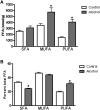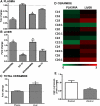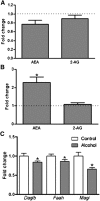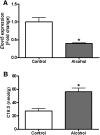Altered hepatic lipid metabolism in C57BL/6 mice fed alcohol: a targeted lipidomic and gene expression study
- PMID: 21856784
- PMCID: PMC3196234
- DOI: 10.1194/jlr.M017368
Altered hepatic lipid metabolism in C57BL/6 mice fed alcohol: a targeted lipidomic and gene expression study
Abstract
Chronic alcohol consumption is associated with fatty liver disease in mammals. The object of this study was to gain an understanding of dysregulated lipid metabolism in alcohol-fed C57BL/6 mice using a targeted lipidomic approach. Liquid chromatography tandem mass spectrometry was used to analyze several lipid classes, including free fatty acids, fatty acyl-CoAs, fatty acid ethyl esters, sphingolipids, ceramides, and endocannabinoids, in plasma and liver samples from control and alcohol-fed mice. The interpretation of lipidomic data was augmented by gene expression analyses for important metabolic enzymes in the lipid pathways studied. Alcohol feeding was associated with i) increased hepatic free fatty acid levels and decreased fatty acyl-CoA levels associated with decreased mitochondrial fatty acid oxidation and decreased fatty acyl-CoA synthesis, respectively; ii) increased hepatic ceramide levels associated with higher levels of the precursor molecules sphingosine and sphinganine; and iii) increased hepatic levels of the endocannabinoid anandamide associated with decreased expression of its catabolic enzyme fatty acid amide hydrolase. The unique combination of lipidomic and gene expression analyses allows for a better mechanistic understanding of dysregulated lipid metabolism in the development of alcoholic fatty liver disease.
Figures






Similar articles
-
Coffee peel polyphenols ameliorate nonalcoholic fatty liver disease by modulating cannabinoid receptor type-1-ceramide axis.Phytother Res. 2025 May;39(5):2312-2323. doi: 10.1002/ptr.8078. Epub 2025 Mar 26. Phytother Res. 2025. PMID: 40135380
-
Endocannabinoid dysregulation in the pancreas and adipose tissue of mice fed with a high-fat diet.Obesity (Silver Spring). 2008 Mar;16(3):553-65. doi: 10.1038/oby.2007.106. Epub 2008 Jan 17. Obesity (Silver Spring). 2008. PMID: 18239598
-
Paracrine activation of hepatic CB1 receptors by stellate cell-derived endocannabinoids mediates alcoholic fatty liver.Cell Metab. 2008 Mar;7(3):227-35. doi: 10.1016/j.cmet.2007.12.007. Cell Metab. 2008. PMID: 18316028
-
Anandamide uptake explained?Trends Pharmacol Sci. 2012 Apr;33(4):181-5. doi: 10.1016/j.tips.2012.01.001. Epub 2012 Jan 31. Trends Pharmacol Sci. 2012. PMID: 22297258 Review.
-
Immunomodulatory lipids in plants: plant fatty acid amides and the human endocannabinoid system.Planta Med. 2008 May;74(6):638-50. doi: 10.1055/s-2008-1034302. Epub 2008 Feb 14. Planta Med. 2008. PMID: 18275004 Review.
Cited by
-
Hepatic stellate cell activation: A source for bioactive lipids.Biochim Biophys Acta Mol Cell Biol Lipids. 2019 May;1864(5):629-642. doi: 10.1016/j.bbalip.2019.02.004. Epub 2019 Feb 5. Biochim Biophys Acta Mol Cell Biol Lipids. 2019. PMID: 30735856 Free PMC article.
-
β-Hydroxybutyrate protects from alcohol-induced liver injury via a Hcar2-cAMP dependent pathway.J Hepatol. 2018 Sep;69(3):687-696. doi: 10.1016/j.jhep.2018.04.004. Epub 2018 Apr 27. J Hepatol. 2018. PMID: 29705237 Free PMC article.
-
Constitutive androstane receptor mediates PCB-induced disruption of retinoid homeostasis.Toxicol Appl Pharmacol. 2019 Oct 15;381:114731. doi: 10.1016/j.taap.2019.114731. Epub 2019 Aug 23. Toxicol Appl Pharmacol. 2019. PMID: 31449830 Free PMC article.
-
Pathogenesis of Alcohol-Associated Fatty Liver: Lessons From Transgenic Mice.Front Physiol. 2022 Jul 5;13:940974. doi: 10.3389/fphys.2022.940974. eCollection 2022. Front Physiol. 2022. PMID: 35864895 Free PMC article. Review.
-
Inhibition of Hepatotoxicity by a LXR Inverse Agonist in a Model of Alcoholic Liver Disease.ACS Pharmacol Transl Sci. 2018 Sep 14;1(1):50-60. doi: 10.1021/acsptsci.8b00003. Epub 2018 Jul 25. ACS Pharmacol Transl Sci. 2018. PMID: 31696159 Free PMC article.
References
-
- Lakshman M. R. 2004. Some novel insights into the pathogenesis of alcoholic steatosis. Alcohol. 34: 45–48 - PubMed
-
- Sozio M. S., Liangpunsakul S., Crabb D. 2010. The role of lipid metabolism in the pathogenesis of alcoholic and nonalcoholic hepatic steatosis. Semin. Liver Dis. 30: 378–390 - PubMed
-
- Oresic M. 2009. Metabolomics, a novel tool for studies of nutrition, metabolism and lipid dysfunction. Nutr. Metab. Cardiovasc. Dis. 19: 816–824 - PubMed
Publication types
MeSH terms
Substances
Grants and funding
LinkOut - more resources
Full Text Sources
Molecular Biology Databases

